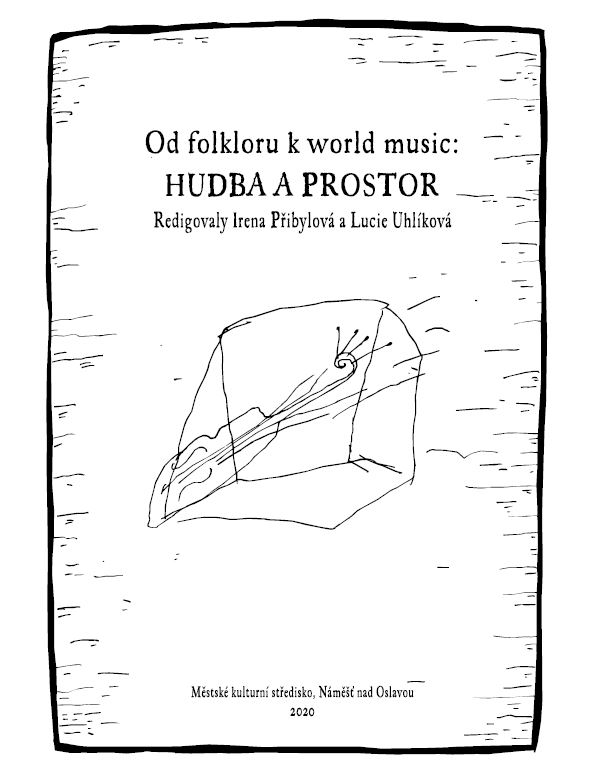Colloquy 2020

The 17th annual From Folklore to World Music colloquy, as well as its home base in Náměšť nad Oslavou, the Folk Holiday Festival, were affected by the Covid pandemic in 2020. The festival included several streamed concerts only, and the number of people in the audience was limited. The colloquy moved from its traditional place in the municipal town-hall to the large grounds of the Centre for Environmental Techniques and Technology in Náměšť nad Oslavou. There, on July 28-29, 2020, the colloquy attendees presented their papers: some in person; others in on-line form from distant places. Music and Space, the topic of the colloquy, attracted many of the previous year’s presenters, as well as some new ones, both local and international.
Space, as it is defined in a dictionary of the Czech language, is understood as an unlimited, boundless, or indeterminately infinite location or expanse. If we connected space and music, in general terms, there would be no barrier to divide them. However, in the life of humans, space does indeed have various limits: they can be determined by our place of birth or being, our thinking, or our practical aspirations. These are the personal delimitations within what is otherwise boundless space. Music also has two dimensions: while the substance of its existence is unlimited, it exists in a space that is always somehow defined – across the span of centuries, regions, countries and continents, social strata, music functions, possibilities of interpretation, and even the composers themselves. Music and space can thus co-exist as both unlimited entities and as islands – which we can anchor at, sail away from, or never venture from at all.
The colloquy’s two days traditionally distinguish between the topics. Day one is devoted to papers on traditional music; day two is open to a variety of minority genres and world music. However, sometimes the topics overleap. Traditional music is linked with specific places in its very essence. In 2020, the speakers discussed the influence of geographical space on the forms of Czech, Moravian, Silesian, and German folksongs, on their vocal performance, as well as on some aspects in the folk-music-influenced works of Leoš Janáček. Other presenters commented on the changes of the environment of folk songs due to social development, and on efforts to record songs for future generations, to revive them and give them new functions, to make them national symbols, or, sadly, to change them into a mere scenic genre, that is, a tourist attraction, or capital in advertising. Some speakers focused on music and migration, interethnic contact, and the search for roots and artistic self-realization. Irish and Sephardic diasporas were discussed, as well as those of Bulgarian, Polish, and Estonian musicians. Various world music issues were presented with examples of music and space topics from India, Greece, the Middle East, and Japan. American blues music and space were explored in a very appropriate way: maps. Czech-Canadian connections were documented on the development of Czech “tramp” songs. Apart from geographical space, stage and
film space were also discussed, particularly in connection with musicals about folk anti-heroes and outlaws. Finally, the Covid quarantine and its impact on the lives and performances of singers and musicians was analysed.
The colloquy provided a friendly meeting point for the exchange of ideas on music and space, and despite the difficult conditions, the success of the event proved that challenges could be faced and overcome.
(introduction)
From Folklore to World Music: MUSIC AND SPACE
- Marta Toncrová | Lidová píseň a prostor (na příkladu Moravy a Slezska) (PDF)
- Jarmila Procházková | Hudba, čas a prostor v progresivní reflexi Leoše Janáčka (PDF)
- Marta Ulrychová | Hledaný „modus vivendi“ německého výboru Státního ústavuHledaný „modus vivendi“ německého výboru Státního ústavupro lidovou píseň v podmínkách Československé republikya jeho působení na Slovensku (PDF)
- Martina Pavlicová | Vykročení mimo vlastní prostor: cesta k současným etnokulturním tradicím (PDF)
- Martina Pavlicová | Stepping Out of Their Own Space: A Journey to Contemporary Ethnocultural Traditions (PDF)
- Lucie Uhlíková | Mezi venkovem a městem: proměny „životního prostoru“ lidových tradic v kontextu vývoje folklorního hnutív českých zemích ve druhé polovině 20. století (PDF)
- Lucie Uhlíková | Between the Countryside and the City: Changes of the Living Space of Folk Traditions and the Development of the Folklore Movement in the Czech Lands in the Second Half of the 20th Century (PDF)
- Ewa Żurakowska | Folk Space Odyssey: Traveling towards the Musical Roots (PDF)
- Iivy Zájedová | Svět vytvořený runovými písněmi: propojení prostoru a hudby v tvorbě Veljo Tormise (PDF)
- Kateřina García | Na vrby toho kraje jsme zavěsili své citery: Zamyšlení nad úlohou geografie a existenčního prostoru v písních irské a sefardské diaspory (PDF)
- Kateřina García | "On the Willows There We Hung Up Our Lyres”: Reflections on the Role of Geography and Existential Space in the Songs of the Irish and Sephardic Diaspora (PDF)
- Jan Sobotka | Got a Map to the Highway, Baby…: Blues a kartografie (PDF)
- Irena Přibylová | Kanada a my v trampských písních (PDF)
- Petr Dorůžka | Modální hudba Blízkého východu a Indie, kulturní identita, porušování pravidel a improvizace (PDF)
- Jiří Moravčík | Bubenický rituál taiko, v němž se člověk proměňuje ve zvuk (PDF)
- Milan Tesař | Hudebníci a virtuální prostor nejen v době koronavirové (PDF)
- Aleš Opekar | Divoký východ aneb Na zbojnickou notu v českých muzikálech (PDF)
- Medailony autorů (PDF)
- Notes on Contributors (PDF)
- Celá publikace (PDF)


